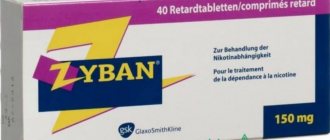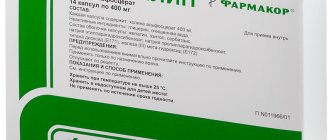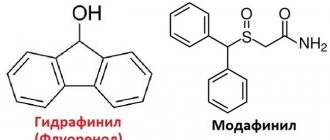Pharmacological properties of the drug Zopiclone
The first representative of a new class of psychotropic drugs - cyclopyrrolon derivatives, structurally different from benzodiazepines and barbiturates. The sedative and hypnotic effect is due to a high degree of affinity for binding sites on the GABA receptor complex in the central nervous system. After taking zopiclone, sleep quickly occurs, characterized by a normal phase structure and duration; The duration of the REM sleep phase does not decrease. The half-life is 5.5–6 hours. Repeated doses do not lead to the accumulation of zopiclone or its metabolites. Unlike benzodiazepine and barbiturate hypnotics, zopiclone does not cause post-somnia drowsiness and a feeling of weakness.
Oral tablets Zopiclon 7,5-SL (Zopiclon 7,5-SL)
Instructions for medical use of the drug
Description of pharmacological action
Promotes sleep, has a calming, anticonvulsant and muscle relaxant effect.
Indications for use
Sleep disorders (difficulty falling asleep, waking up at night or early), incl. secondary to mental disorders.
Release form
film-coated tablets 7.5 mg; contour packaging 10, cardboard pack 1; film-coated tablets 7.5 mg; contour packaging 10, cardboard pack 2; Composition 1 film-coated tablet contains zopiclone 7.5 mg and other excipients - lactose monohydrate, magnesium stearate, hypromellose, titanium dioxide, wheat starch, calcium dihydrogen phosphate, sodium carboxymethyl starch; 10 pcs in a blister pack, 1 or 2 packs in a cardboard box.
Pharmacodynamics
Promotes sleep, has a calming, anticonvulsant and muscle relaxant effect.
Pharmacokinetics
Well absorbed from the gastrointestinal tract. Cmax in plasma is achieved after 1–1.5 hours. T1/2 is 3.5–6 hours. Excreted unchanged (4–5%) and in the form of metabolites by the kidneys (up to 80%) and with feces (16%) .
Use during pregnancy
Contraindicated during pregnancy. Breastfeeding should be stopped during treatment.
Contraindications for use
Hypersensitivity, severe respiratory failure, Erb-Goldflam disease (myasthenia gravis), severe liver dysfunction, attacks of sleep apnea, pregnancy, breastfeeding, children and adolescents under 18 years of age.
Side effects
From the nervous system and sensory organs: headache, dizziness, prolonged drowsiness, rarely - increased irritability, hallucinations, aggressiveness, depression after sleep. From the gastrointestinal tract: dryness and metallic taste in the mouth, nausea. Allergic reactions: allergic skin reactions.
Directions for use and doses
Inside, before going to bed, with a small amount of liquid. The dosage is determined by the doctor. Typically, adults - 7.5 mg/day. For patients with liver dysfunction, chronic respiratory failure or the elderly - 3.75 mg/day, if necessary - up to 7.5 mg/day. Against the background of severe renal impairment - 3.75 mg/day.
Overdose
Symptoms: central nervous system depression (from drowsiness to loss of consciousness). Treatment: gastric lavage, taking activated carbon, symptomatic therapy.
Precautions for use
Should not be used during work by vehicle drivers and people whose profession involves increased concentration of attention. It must be kept in mind that there is a risk of developing addiction.
Storage conditions
List B: In a dry place, protected from light, at a temperature of 15–25 °C.
Best before date
36 months
ATX classification:
N Nervous system
N05 Psycholeptics
N05C Hypnotics and sedatives
N05CF Benzodiazepine-like drugs
N05CF01 Zopiclone
Special instructions for the use of Zopiclone
The use of zopiclone should be avoided during pregnancy and breastfeeding. Patients taking zopiclone should refrain from performing potentially hazardous activities that require increased alertness. Abrupt cessation of treatment does not cause the development of withdrawal syndrome. During treatment, you should avoid drinking alcohol and taking depressant psychotropic drugs. In cases of use of zopiclone for myasthenia gravis, strict neurological monitoring must be ensured due to the possible increase in muscle weakness.
Study design
The English researchers used data from 27,090 patients with dementia.
The study authors compared the side effects of 3,532 patients prescribed Z-drugs for the first time with 1,833 patients with sleep disorders prescribed non-sedating medications, 10,214 patients prescribed non-sedating medications in a general practitioner setting, and 5,172 patients prescribed benzodiazepines for the first time.
High dose Z-drugs and benzodiazepines were equivalent to ≥7.5 mg zopiclone or >5 mg diazepam.
As primary endpoints
examined fracture, falls, mortality, acute bacterial infections, ischemic stroke/transient ischemic attack, and venous thromboembolism over 2 years of follow-up.
Cases of overdose
If the dosage was intentionally or accidentally violated, the following disorders may occur:
- from the gastrointestinal tract : a feeling of bitterness in the mouth, a metallic taste, dryness of the mucous membranes of the oral cavity and dyspeptic disorders;
- from the central nervous system : severe headache, dizziness and loss of consciousness, memory loss (anterograde form), hallucinations, nightmares and confusion;
- from dermatological manifestations : skin rash of various localization, pinpoint and spotty forms.
The amount of the drug required for the occurrence of adverse reactions is purely individual and depends on the compensatory capabilities of the body.
Scope of application and contraindications
The sleeping pill Zopiclone is used for the following purposes:
- primary/secondary sleep disorders : difficulty falling asleep, waking up at night; early awakening, dissatisfaction with the quality of sleep, neuroses at night, sleep disorders, jet lag;
- insomnia : transient-periodic (episodic), situational (single-stage) and chronic;
- mental illnesses and disorders manifested by dissomnia : loss of a loved one, depressive states, anxiety disorders, chronic alcoholism, history of panic disorder;
- existing bronchial asthma, which manifests itself with night attacks - Zopiclone in this case is used in combination with a single use of Theophyllini.
Contraindications for use:
- severe respiratory failure (for example, with chronic obstructive pulmonary disease, bronchial asthma);
- hypersensitivity to the components of the drug ;
- pregnancy - use is contraindicated in all trimesters, which is associated with teratogenic and toxic effects on the fetus in certain doses or during certain periods of pregnancy;
- lactation period - due to the possibility of active substances getting into breast milk, medication intake is limited for the entire period of breastfeeding;
- age up to 15 years (according to Vidal 2021 recommendations);
- bulbar-spinal asthenia.
results
- The average age of the patients was 83 years. 62% of patients were women. It was noted that among 3532 patients who started taking Z-drugs, 17% started taking them at a high dose.
- In patients receiving high-dose Z-drugs, compared with patients with sleep disorders who did not receive drugs, the risk of fractures increased by 1.67 times, femoral fracture by 1.96 times, falls by 1.33 times, and ischemic heart failure. stroke by 1.88 times.
- Similar results were observed when compared with non-sedative medications prescribed by primary care physicians.
- Minimal risks were observed when using doses ≤ 3.75 mg of zopiclone.
- There was no significant increase in risk with the use of Z-drugs compared with non-sedative drugs in terms of mortality, infections and venous thromboembolism.
- There were no significant differences in the incidence of adverse events between Z-drugs and benzodiazepines, excluding a 27% reduction in mortality for Z-drugs (hazard ratio, 0.73 [95% CI, 0.64 to 0.83]).
Dependency[edit | edit code]
Zopiclone, a benzodiazepine-like drug, was initially presented as having a reduced risk of dependence and withdrawal symptoms compared with traditional benzodiazepine drugs. In reality, however, zopiclone may have a slightly greater addiction potential than benzodiazepines.
.[8][9][10] Tolerance to the effects of zopiclone may develop over several weeks. In most cases, long-term use of the drug should be avoided. Successful treatment of patients with severe insomnia due to anxiety can be achieved within a few months. Abrupt cessation, especially when taking high doses of the drug over a long period of time, can cause seizures and delirium in severe cases.[11][12]
Publications in the British Medical Journal provide no evidence that zopiclone has a low potential for addiction. In fact, physical dependence, abuse, and withdrawal symptoms similar to those observed with benzodiazepine withdrawal often occur with the drug. Withdrawal symptoms include restlessness, tachycardia, tremors, sweating, hot flashes, palpitations, derealization, and later insomnia.[13] Withdrawal seizures have also been reported during Zopiclone detoxification, however in this case the person was abusing high doses of Zopiclone.
The risk of developing dependence when taking zopiclone for less than 2 weeks or less is very low.[14] However, this is disputed by one study of low-dose zopiclone taken over 7 nights. Stopping zopiclone has been found to cause a relapse of insomnia. Additionally, when midazolam was discontinued after continuous use for 7 nights, no relapse of insomnia was observed, suggesting that zopiclone may cause more significant problems of tolerance and dependence than benzodiazepines.[15] After 3 weeks of use, mild to moderate symptoms of relapse occur when zopiclone is stopped. Due to the risk of developing tolerance and physical dependence, zopiclone is recommended to be used for a short period of time (maximum 1-4 weeks), or, conversely, to rarely use the drug for long periods of time.[16]
Long-term users of Zopiclone who have become physically dependent on the drug should not abruptly stop taking the substance as severe withdrawal symptoms such as delirium may be associated with it.[17] If zopiclone has been taken for several weeks or more, stopping the drug should be done by gradually reducing the dose or switching to an equivalent dose of diazepam (Valium), which has a much longer half-life, making withdrawal easier, and then gradually over several months. reduce the dosage to avoid the development of extremely severe and unpleasant withdrawal symptoms (such as internal restlessness, psychomotor agitation, abdominal pain, hypertension, hallucinations, seizures, anxiety, depression, psychosis, etc.), which can last up to two years if the drug is stopped too abruptly.[18][19][20] After 4 weeks of using zopiclone at night, some users develop daytime anxiety associated with stopping the drug. This symptom, however, does not occur as intensely as with triazolam, which has a much shorter duration of action and produces more severe symptoms of daytime withdrawal anxiety in long-term users.[21] According to the World Health Organization, Zopiclone, although not molecularly a benzodiazepine, is capable of binding non-selectively and with high affinity to the same benzodiazepine binding site as benzodiazepines. The World Health Organization has also stated that zopiclone is cross-tolerant with benzodiazepines and these drugs may be interchangeable.[22]
Pharmacokinetics of the drug
The drug is well absorbed from the gastrointestinal tract, has a short-term effect (therefore, there is no morning drowsiness after its use) and does not have a cumulative effect.
Metabolism occurs in the liver (oxidation and hydroxylation) with a half-life (t1/2) of about 6 hours. The maximum concentration in plasma is observed after 70-75 minutes. About 5% of the drug is excreted unchanged, 75% by the kidneys, and 20% with feces. Some data from recent years indicate a small amount of the drug secreted by the salivary glands.
Inducers and blockers of cytochrome P450, respectively, accelerate or slow down the clearance of substances. Adjustment (reduction) of the drug is required for liver diseases and when prescribing the drug for elderly patients.
The drug is capable of passing through the histohematic, blood-brain and placental barriers. When passing through the placenta, it is able to penetrate into mother’s milk (the amount of the drug is 2 times less than in plasma). Metabolism occurs in the liver with the formation of three metabolites: two inactive and a low-active amine oxide.







